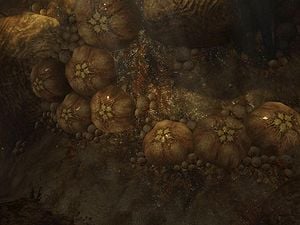Flood hive
From Halopedia, the Halo wiki
A Flood hive[1] is an important step in the development of the Flood life-cycle. The processes that develop a hive begin during the Coordinated Stage of Flood development, once a viable Gravemind has been developed and the Flood has access to a sizable population. The Gravemind is a collection of the sentience and knowledge that has been gathered by the victims of the Flood parasites. Once a hive has been established, it serves as a base for Flood assaults as well as housing a Flood Gravemind. There have been two notable examples of Flood hives in the modern era; High Charity and the crashed Flood-captured battlecruiser in Voi.
Creation
Early stages
In order for a hive to be founded, the Flood must have access to a suitably large populace and an environment capable of sustaining Flood life. The population of the area has to contain high enough calcium deposits to sustain the Flood parasite.
Once a useful area has been found, the Flood proceed to attack the hosts present, gathering food and biomass. The Flood attack with a strategy relying primarily on numerical superiority. The parasite then begins to pump spores into the atmosphere,[2][3] restricting breathing for the hosts present, causing them to die of asphyxiation, or weakening them in order to make them less resistant to assimilation. This is accomplished, at least in part, through the creation of structures known as spore mountains. These peak-like agglomerations of biomass are used to generate Flood spores and release them into the atmosphere. There are known instances of spore mountains reaching hundreds of kilometers in diameter and dozens in height.[4]
Hosts who are infected will add to the Flood's arsenal. Older combat forms will develop into carrier forms, which generate more infection forms, continuing the cycle. During this time, Flood growth pods start to grow on surfaces. Growth pods are constructed from flesh, and grow at an extraordinary rate.
Later stages
Once the Flood has access to enough calcium, they begin to develop a hardened carapace, onto which they add Flood Super Cells to form pure forms, a form of independent Flood drone which has no need for a host. As a result of this development, combat forms are relegated to defensive positions or are converted into more pure forms.[5]
The functions of objects, such as doors, are replaced as Flood biomass grows over the original architecture. Under the Gravemind's direction, life support systems are sabotaged in order to speed up the demise of the inhabitants.[6] The pouch forms eventually consume most or all of the original area. The growth pods grow large, bubble-like growths, which incubate new infection forms, essentially replacing carrier forms and further reducing the Flood's dependence on hosts.
Once the process is complete, the Flood disposes of almost all need for new biomass, becoming self-sustaining. Despite this, due to the Flood's natural instinct to infect and consume all life, the parasite rarely becomes content at this stage.
Trivia
Interestingly, there seems to be less green mist in the later stages of Flood hive creation. This is easily noticeable from the Halo 2 level High Charity to Halo 3 level Cortana. It is possible that all the Flood spores floating in the air settled down and created the hive.
Gallery
343 Guilty Spark imagines Installation 04 with a Flood hive on its surface.
List of appearances
- Halo 2 (First appearance)
- Halo 3
- Halo: Combat Evolved Anniversary
- Halo: Primordium
- Halo: Silentium
Sources
- ^ Halo 3, campaign level Floodgate
- ^ Halo 2, campaign level High Charity
- ^ Halo: Combat Evolved, campaign level The Library, 343 Guilty Spark (04-343 Guilty Spark: "Your environment suit will serve you well when the Flood begin to alter the atmosphere. You are a good planner!")
- ^ Halo: Silentium, page 82
- ^ Halo 3
- ^ Halo 2, Dialogue Placeholders (Cortana: "Flood spores have contaminated the city's life-support infrastructure, the filtration systems are overloading!")
| |||||||||||||||||||||||||||||||||


